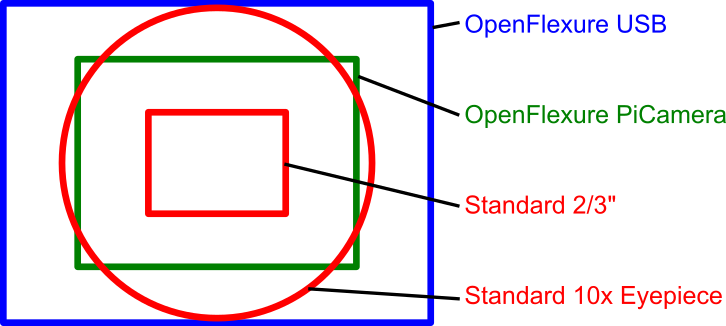-
Notifications
You must be signed in to change notification settings - Fork 57
Resolution and Field of View
The quality of image you can obtain with a microscope depends largely on two numbers: the resolution and the field of view. Put simply, the resolution is the smallest feature you can see with the microscope, and the field of view is the size of the region of the sample you can see at once. This page is a quick reference for the optics used in the OpenFlexure microscope, with some commonly-used microscopes added for comparison. For a fuller explanation see magnification, resolution, and field of view.
The resolution is set by the objective lens, though the illumination also has an effect (e.g. using a condenser lens or a diffuser tends to improve the resolution).
| Lens | Resolution | Sample-to-sensor magnification |
|---|---|---|
| Raspberry Pi Camera v1 | ~2um | 10.6 (40mm stage) |
| Raspberry Pi Camera v2 | ~1.5um | 13.2 (40mm stage) |
| M12 lens in USB camera kit | <2um | 14.9 (65mm stage) |
| 4x, 0.1NA objective | 4.4um | 0.86* (65mm stage) |
| 10x, 0.25NA objective | 1.76um | 2.2* (65mm stage) |
| 20x, 0.4NA objective | 1.1um | 4.3* (65mm stage) |
| 40x, 0.65NA objective | 0.7um | 8.6 (65mm stage) |
| 100x, 1.25NA objective | 0.35um | 21.6 (65mm stage) |
| Figures with a * are estimated. The stage heights are shown because the length of the optics module affects magnification - 40mm and 65mm are the two standard heights so far used in developing the optics. |
NB the objective lenses quoted above are typical values for lenses you might find in a research lab. If you're comparing them to lenses in a microscope kit, make sure to check the numerical aperture (NA) as that's what determines the resolution. The values in the table above are theoretical, at 532nm.
The field of view depends on the camera sensor size or eyepiece aperture of the microscope, and the magnification of the optics up to that point. The sensor sizes for cameras commonly used in the OpenFlexure Microscope are below:
| Sensor | Native Resolution | Pixel Size | Sensor Size (XxY) | Sensor Diagonal |
|---|---|---|---|---|
| Raspberry Pi Camera v1 | 2592x1944 | 1.4um | 3.63x2.72mm | 4.54mm |
| Raspberry Pi Camera v2 | 2464x3280 | 1.12um | 3.67x2.76mm | 4.60mm |
| Logitech C270 | 1280x720 | 2.8um | 3.58x2.02mm | 4.11mm |
| 5 Megapixel USB Camera (from kit) | 1400x1050 (1) | 4um (1) | 5.6x4.2mm (2) | 7.0mm (2) |
| (1) When we ran this test the 5Mp camera was only running at 1.4Mp; we're working on the software for this! | ||||
| (2) This is estimated, rather than taken from the spec sheet of the chip. |
To calculate the size of the image, simply divide the the sensor size in mm from the second table by the "sample-to-sensor magnification" value from the first table. To get the size of one pixel, do the same with the pixel size. The table below shows the diagonal field-of-view for the OpenFlexure Microscope using a Raspberry Pi camera, the USB 5Mp camera supplied in our kits, and a comparison to the same objective in a lab microscope using a 2/3" video camera and 10x eyepieces.
| PiCam v2 | Our USB Cam. | Lab Microscope + 2/3" Sensor | 10x Eyepieces | |
|---|---|---|---|---|
| PiCam v2 lens (1) | 350um | |||
| M12 lens (in kit) | 309um | 470um | ||
| 4x Objective | 5350um | 8140um | 2700um | 4250um |
| 10x Objective | 2168um | 3240um | 1080um | 1700um |
| 20x Objective | 1084um | 1628um | 540um | 950um |
| 40x Objective | 542um | 814um | 270um | 425um |
| 100x Objective | 217um | 324um | 108um | 170um |
(1) The Pi Camera lens v2 figure is given for a 40mm stage. Everything else in the table is for a 65mm stage. (2) Objective values are calculated, based on a measurement with the 40x objective.

The bottom line is that the basic OpenFlexure Microscope, using the lens from v2 of the Raspberry Pi camera, has a resolution roughly equivalent to a lab microscope with a decent 20x objective lens, but the magnification is closer to that of a 50x objective. The USB kit (using the lens supplied with the camera) gets a slightly larger field of view, and a slightly coarser resolution. In a lab microscope equipped with a video camera, the sample-to-sensor magnification is generally the magnification specified on the objective, while the sensor size depends on the camera. NB camera sizes given in fractions-of-an-inch are not actual sensor sizes - see the Sensor Format page on Wikipedia. The comparison above quotes values for a 2/3" sensor (10.8mm diagonal), which is a typical size of sensor (fast CMOS sensors are often smaller than this, expensive microscopy cameras can be somewhat larger). The eyepieces assume a 17mm "field number", which is about typical for 10x oculars.